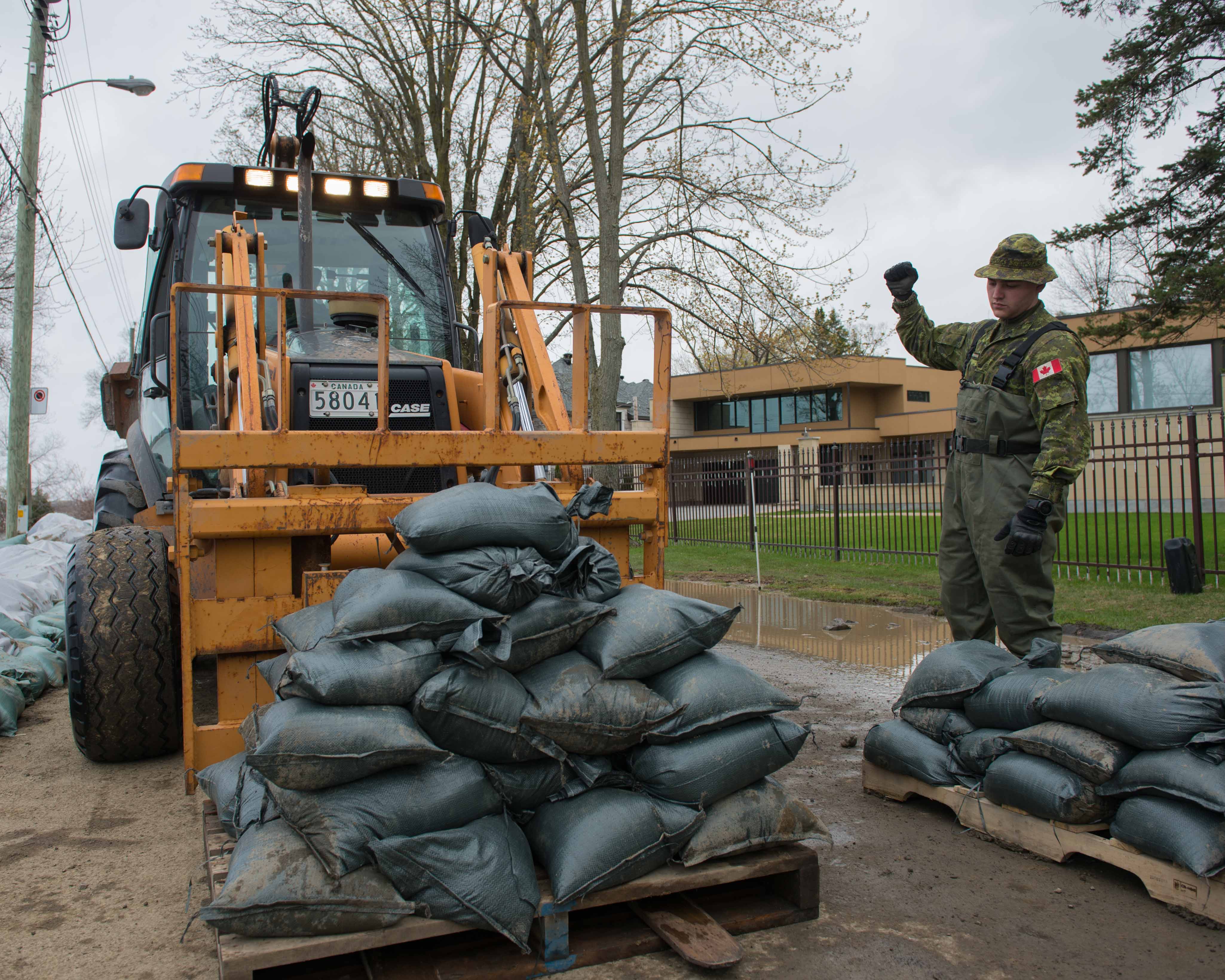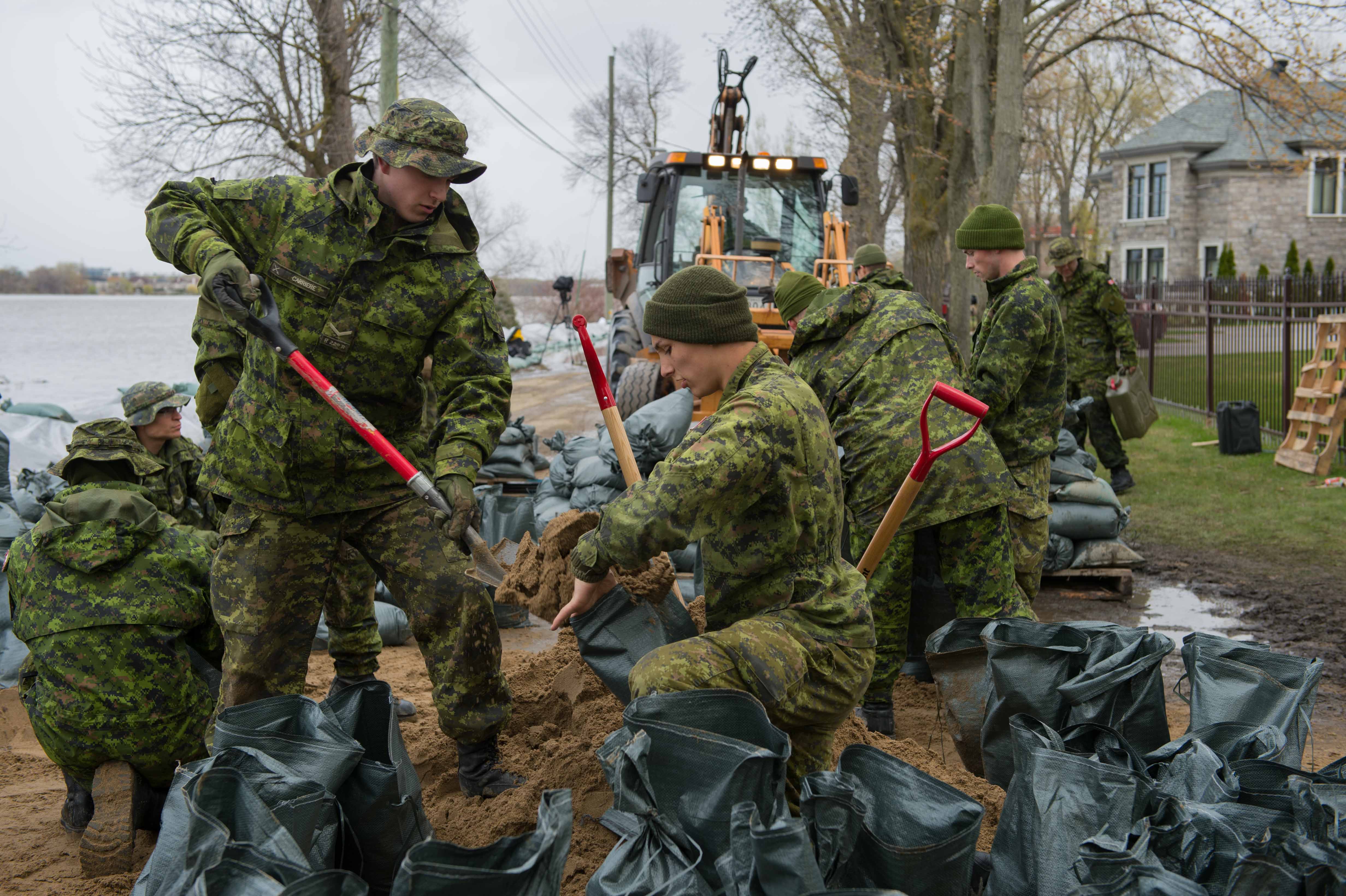Members from 5e Régiment d'artillerie légère du Canada talk to residents in a canoe affected by flooding while assessing the situation of a community in Bécancour, Quebec during Operation LENTUS on May 7, 2017.
Photo: Cpl Nathan Moulton, Imagery Valcartier
VL02-2017-0047-037
~
Des membres du 5e Régiment d'artillerie légère du Canada discutent avec des résidents touchés par les inondations qui se trouvent à bord d’un canot, lors de l’évaluation de la situation dans une communauté de Bécancour, au Québec, au cours de l’opération LENTUS, le 7 mai 2017.
Photo : Cpl Nathan Moulton, Services d’imagerie de Valcartier
VL02-2017-0047-037
The worst flooding to hit eastern Canada in 50 years will undoubtedly come at an enormous cost, both to home-owners and to all levels of government. But as climate change fuels more-and-more natural disasters across the country, there is growing concern that bailing out those affected by the disaster might be simply unsustainable.As of right now, Ottawa still has no clear idea of who’s footing the bill.We have not, in the past few days, had any focus on the cost issues,” Ralph Goodale told reporters Monday. “The key thing is to make sure the resources are there to keep people safe.”If history can tell us anything, the cost of this week’s flooding in eastern Canada will likely be paid for by a mix of insurance and government disaster relief funding. When the 2013 floods evacuated 100,000 people from southern Alberta, the cost was estimated at more than $6 billion.That figure was shared by homeowners, the provincial and municipal governments, plus more than $1 billion in federal assistance from the Disaster Financial Assistance Arrangements program and $1.7 billion in insurance payments.But with the risk of flooding increasing due to climate change and increased development in flood-prone areas, federal and provincial governments are looking for ways to limit the amount of payout, and are encouraging homeowners to buy private insurance instead. In February 2016, the Parliamentary Budget Officer declared the disaster assistance program payments unsustainable, saying its costs had increased over the past five years due to weather that caused heavy damage. It estimated that over the next five years, it would pay nearly $1 billion a year in disaster relief payments, although its annual budget is only $100 million. Flooding is expected to account for 75 percent of that cost.Speaking to VICE News from Montreal, climate change economist Laurent Da Silva said he lives on Mount Royal so he wasn’t affected by the flooding, but he visited his former neighbourhood that has been devastated by the rising water. “The situation there is critical,” he said.The economist with Ouranos, a non-profit focused on climate adaptation, expects the provincial and federal governments will pay for a large portion of the damage, as they have historically, “but this is not a very sustainable way to look at the problem.”Encouraging homeowners to buy overland flood insurance could be one way to adapt: If the expensive premium for living on a floodplain is paid for by the homeowner, there will be a shift in where people decide to live, he says. “It could be an interesting way to maybe change our urban planning.”“This will be part of the equation now: Houses on floodplains will be less attractive and people will decide to live somewhere else.”
In February 2016, the Parliamentary Budget Officer declared the disaster assistance program payments unsustainable, saying its costs had increased over the past five years due to weather that caused heavy damage. It estimated that over the next five years, it would pay nearly $1 billion a year in disaster relief payments, although its annual budget is only $100 million. Flooding is expected to account for 75 percent of that cost.Speaking to VICE News from Montreal, climate change economist Laurent Da Silva said he lives on Mount Royal so he wasn’t affected by the flooding, but he visited his former neighbourhood that has been devastated by the rising water. “The situation there is critical,” he said.The economist with Ouranos, a non-profit focused on climate adaptation, expects the provincial and federal governments will pay for a large portion of the damage, as they have historically, “but this is not a very sustainable way to look at the problem.”Encouraging homeowners to buy overland flood insurance could be one way to adapt: If the expensive premium for living on a floodplain is paid for by the homeowner, there will be a shift in where people decide to live, he says. “It could be an interesting way to maybe change our urban planning.”“This will be part of the equation now: Houses on floodplains will be less attractive and people will decide to live somewhere else.” There’s a problem, though. Overland flooding insurance isn’t readily available for most Canadians — flood insurance usually only covers flooding from sewer systems. Ouranos is working with the industry to show that it’s profitable to offer this coverage in their premiums.“The insurance industry is starting to get more and more interested in trying to insure these kind of losses, but it’s still a quite new area for them, in Canada at least,” Laurent says.University of Waterloo researchers behind a study published last month, Canadian Voices on Changing Flood Risk, argue that homeowners don’t have enough information to make decisions on buying insurance or protecting their homes. Flood maps are outdated or difficult to access, they say, and there’s no onus on people selling their homes to disclose if their property is on a floodplain.The researchers surveyed 2,300 people across Canada from communities with high flood risk and found that although 83 percent of those surveyed believed they had a responsibility to protect their own property from flood damage, only six percent of homeowners knew they lived in a designated flood risk area.“The lack of risk awareness is worrying,” the researchers write. “Some provincial governments are no longer willing to provide disaster assistance when insurance is available. Failure to protect property or purchase insurance coverage will leave homeowners solely responsible for damage costs and increase the risk of mortgage defaults.”“Homeowners in this survey who had experienced flood damage received, on average, $30,000 from government to help in recovery. This is a serious gap in protection for most Canadians. In British Columbia for example, a flooded homeowner can expect to receive up to 80 percent of a claim, to a maximum of $300,000, which is less than half of the average home price in the province ($688,000).”They believe more information will solve the problem. They are calling on governments to be upfront about what homeowners can expect to be covered after a disaster, and for homeowners to disclose whether their property is on a floodplain during real estate transactions.“As the responsibility for flood protection and financial liability for flood damages increase for Canadians, it is critical that governments and providers of property-level flood risk information be transparent and enable homeowners to be active, engaged and informed participants in Canada’s future flood risk management strategy.”
There’s a problem, though. Overland flooding insurance isn’t readily available for most Canadians — flood insurance usually only covers flooding from sewer systems. Ouranos is working with the industry to show that it’s profitable to offer this coverage in their premiums.“The insurance industry is starting to get more and more interested in trying to insure these kind of losses, but it’s still a quite new area for them, in Canada at least,” Laurent says.University of Waterloo researchers behind a study published last month, Canadian Voices on Changing Flood Risk, argue that homeowners don’t have enough information to make decisions on buying insurance or protecting their homes. Flood maps are outdated or difficult to access, they say, and there’s no onus on people selling their homes to disclose if their property is on a floodplain.The researchers surveyed 2,300 people across Canada from communities with high flood risk and found that although 83 percent of those surveyed believed they had a responsibility to protect their own property from flood damage, only six percent of homeowners knew they lived in a designated flood risk area.“The lack of risk awareness is worrying,” the researchers write. “Some provincial governments are no longer willing to provide disaster assistance when insurance is available. Failure to protect property or purchase insurance coverage will leave homeowners solely responsible for damage costs and increase the risk of mortgage defaults.”“Homeowners in this survey who had experienced flood damage received, on average, $30,000 from government to help in recovery. This is a serious gap in protection for most Canadians. In British Columbia for example, a flooded homeowner can expect to receive up to 80 percent of a claim, to a maximum of $300,000, which is less than half of the average home price in the province ($688,000).”They believe more information will solve the problem. They are calling on governments to be upfront about what homeowners can expect to be covered after a disaster, and for homeowners to disclose whether their property is on a floodplain during real estate transactions.“As the responsibility for flood protection and financial liability for flood damages increase for Canadians, it is critical that governments and providers of property-level flood risk information be transparent and enable homeowners to be active, engaged and informed participants in Canada’s future flood risk management strategy.”
Advertisement

Advertisement

Advertisement